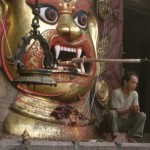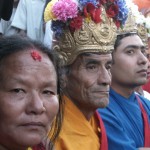They say that if you can make it in New York, you can make it anywhere. I say, if you can drive a motorcycle in Kathmandu, you can drive one anywhere.
 Granted, the bikes are small — my 150cc Bajaj Pulsar is about average — but that’s okay, because you can’t really go faster than 40 mph anyway (and that’s when the city streets are clear, at about 3 a.m.). During the day navigation is a surgical skill, accomplished with precision along narrow lanes, many of which were not made for anything wider than a cow. That’s about the width of my scooter; but I’m also sharing the streets with vagrant dogs, taxicabs, the occasional SUV, and a chaotic mix of kids, women in saris, rolling fruit, rickshaws, ice cream carts, balloon sellers, schoolgirls, buses, baskets of onions, and many other (far more aggressive) motorcyclists. All of the above move in what amounts to Brownian motion. The concentration required compares to the most austere Zen practice. There’s no room for error; if I show the slightest bit of indecision, other vehicles roar past me within a hair’s breadth, weaving like drunken bees. If I go down, I won’t be getting up again — one reason why a friend referred to the enterprise as “meditation at gunpoint.”
Granted, the bikes are small — my 150cc Bajaj Pulsar is about average — but that’s okay, because you can’t really go faster than 40 mph anyway (and that’s when the city streets are clear, at about 3 a.m.). During the day navigation is a surgical skill, accomplished with precision along narrow lanes, many of which were not made for anything wider than a cow. That’s about the width of my scooter; but I’m also sharing the streets with vagrant dogs, taxicabs, the occasional SUV, and a chaotic mix of kids, women in saris, rolling fruit, rickshaws, ice cream carts, balloon sellers, schoolgirls, buses, baskets of onions, and many other (far more aggressive) motorcyclists. All of the above move in what amounts to Brownian motion. The concentration required compares to the most austere Zen practice. There’s no room for error; if I show the slightest bit of indecision, other vehicles roar past me within a hair’s breadth, weaving like drunken bees. If I go down, I won’t be getting up again — one reason why a friend referred to the enterprise as “meditation at gunpoint.”
Twenty-five years ago, in 1983, I arrived in Kathmandu for my first extended stay, and wrote Mr.  Raja’s Neighborhood. In October of that same year, I trekked to the Khumbu, the Everest region. A lean, mean 29, I carried a huge pack and spent weeks above 15,000′. This year, I’ll be returning to the Khumbu–this time with adventure travel pioneer Leo Le Bon, who founded Mountain Travel and helped open the area to trekking 40 years ago.
Raja’s Neighborhood. In October of that same year, I trekked to the Khumbu, the Everest region. A lean, mean 29, I carried a huge pack and spent weeks above 15,000′. This year, I’ll be returning to the Khumbu–this time with adventure travel pioneer Leo Le Bon, who founded Mountain Travel and helped open the area to trekking 40 years ago.
This year is also the 20th anniversary of Shopping for Buddhas — a story based on my search for the “perfect” statue, set here in 1988 against the backdrop of fast-changing Kathmandu. Now, 20 years later, I’m on a mission to write a story about how the past two decades have affected my relationship with Nepal.
 I have to say right off: there have been countless changes here, and very few of them have been for the better. “Modern” Kathmandu seems to be the result of fifty years of bad choices, one on the heels of another. Somehow, though, I still love the place, and the crippled sister it has become. As the days pass, I’ll post some vignettes from the Valley. And I’ll try to do some shopping — if I can think of a deity that might be appropriate for this time and place.
I have to say right off: there have been countless changes here, and very few of them have been for the better. “Modern” Kathmandu seems to be the result of fifty years of bad choices, one on the heels of another. Somehow, though, I still love the place, and the crippled sister it has become. As the days pass, I’ll post some vignettes from the Valley. And I’ll try to do some shopping — if I can think of a deity that might be appropriate for this time and place.
